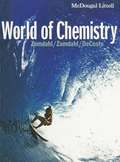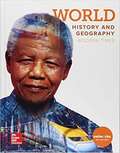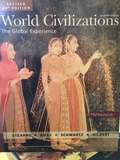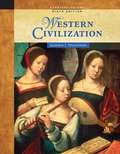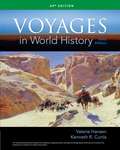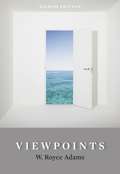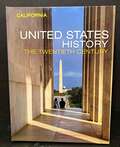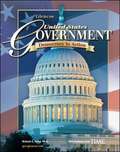Special Collections
District List: LAUSD High School Williams List of District Adopted and Approved Textbooks
- Table View
- List View
Writing America
by David A. Jolliffe and Hephzibah RoskellyWe have designed Writing America: Language and Composition in Context AP* Edition so that it can be used as the foundational text in a course that emphasizes reading, writing, and analyzing texts. Writing America teaches reading as a dynamic, interactive process. It teaches writing as a craft, related to reading, that produces rich, purposeful, well-planned and well-executed texts. It teaches the structure and organization of texts, at the level of both the whole text and the sentence. It couches this instruction in an examination of vitally important works of American literature, art, and culture, accompanied by a study of contemporary pieces that unpack current thinking on the issues and themes raised by the historical works.
World of Chemistry (Second Edition)
by Steven S. Zumdahl and Donald J. Decoste and Susan L. ZumdahlWorld of Chemistry presents the right balance of concepts and applications, emphasizing active learning and encouraging students to solve problems creatively.
World of Chemistry
by Steven S. Zumdahl and Donald J. Decoste and Susan L. ZumdahlNIMAC-sourced textbook
World History the Modern World (California Edition)
by Elisabeth Gaynor Ellis and Anthony EslerHistory textbook
World Geography Today
by David M. HelgrenWorld Geography Today is a guide to learning about the constantly changing world in which you live. This textbook will help you understand the study of geography and make sense of our complex world.
World Geography
by Celeste Fraser and Thomas J. BaerwaldThis program will help you learn content, develop skills, and apply what you know. Examine these pages to understand how this textbook and its online resources can guide you through the study of world geography.
World Geography
by Richard G. Boehm and Jay MctigheDevelop geographic literacy with the only high school geography text co-authored by the National Geographic. Help your students make the connection between geography and history, as well as geography and current events.
World Cultures
by Elisabeth Gaynor Ellis and Iftikhar Ahmad and Herbert Brodsky and Marylee Susan CroftsIn this book, you will learn about people in many parts of the world. Their ways of life have developed over thousands of years. In some ways, their ideas, customs, and traditions differ from one another as well as from those familiar to us in the United States.
World Civilizations
by Michael Adas and Peter N. Stearns and Stuart B. Schwartz and Marc Jason GilbertDesigned for introductory-level survey courses in World History. The primary goal of "World Civilizations" is to present a truly global history--from the development of agriculture and herding to the present. Using a unique periodization, this book divides the main periods of human history according to changes in the nature and extent of global contacts.
This global world history text emphasizes the major stages in the interactions among different peoples and societies, while at the same time assessing the development of major societies. Encompassing social and cultural as well as political and economic history, the book examines key civilizations in world history.
"World Civilizations" balances this discussion of independent developments in the world's major civilizations with comparative analysis of the results of global contact.
World Civilizations
by Michael Adas and Peter N. Stearns and Stuart B. Schwartz and Marc J. GilbertThis AP Edition of World Civilizations: The Global Experience has been especially adapted for the AP exam.
Western Civilization (Combined Volume, 6th Edition)
by Jackson J. SpielvogelThe goal of this undergraduate text is to present a balanced work in which political, economic, social, religious, intellectual, cultural, and military aspects of Western civilization are integrated into a chronologically ordered synthesis. The latest research on social history and women's history is integrated, rather than isolated in separate chapters. For this sixth edition, Spielvogel (Pennsylvania State University) adds material reflecting current scholarship on everything from the Neolithic Age to the war in Iraq, and including considerable new material on the impact other parts of the world have had on the West. Pedagogical features include boxes of primary source documents, detailed chronologies, illustrated timelines, chapter outlines, critical thinking questions, and a glossary. The text's updated color maps feature detailed captions. Annotation ©2008 Book News, Inc., Portland, OR (booknews.com)
Voyages in World History, AP® Edition
by Valerie Hansen and Kenneth R. CurtisNIMAC-sourced textbook
Voyages in World History
by Valerie Hansen and Kenneth R. CurtisVOYAGES IN WORLD HISTORY shows that history is made up of the stories of people. Each chapter centers on a traveler's account that highlights the authors' main theme, the constant movement of people, goods, and ideas. The travelers include merchants, poets, rulers, explorers, soldiers, missionaries, and scholars, and their voyages provide a framework for each chapter that captures students' interest and enthusiasm. Special features help students make connections across chapters, societies, and time periods as they learn about the people, places, and events crucial to understanding world history and its global context.
Viewpoints
by W. Royce AdamsSpark your interest in writing with VIEWPOINTS. This thematically organized reader offers diverse perspectives on various themes and issues, including social concerns, media, human behavior, cultural differences, and human rights. With opening chapters that include substantial writing and reading instruction and writing assignments both at the end of each reading and on the web, VIEWPOINTS takes writing and critical-thinking skills to the next level. This thoroughly revised Eighth Edition builds on the success of previous editions with twenty-four new readings, six new thought-provoking photographs, author biographies, and source information for every selection.
United States History: The Twentieth Century
by Randy Roberts and Peter B. Levy and Emma J. Lapsansky-WernerNIMAC-sourced textbook
United States History & Geography
by Joyce Appleby and Alan Brinkley and Donald A. Ritchie and Albert S. Broussard and James M. McPhersonNIMAC-sourced textbook
United States History
by John J. Newman and John M. SchmalbachTo provide comprehensive review of U. S. history, from pre-Columbian cultures in the Americas to the war in Iraq and thorough preparation for the Advanced Placement exam.
United States Government Our Democracy
by Donald A. Ritchie and Richard C. Remy and M. Ed. and J. D. and Lee Arbetman and Megan L. Hanson and M.S. [et al.]United States Government, Our Democracy © 2018 allows high school students to master an understanding of the structure, function, and powers of government at all levels. Students will develop an appreciation for the value of citizenship and civic participation as they learn and apply the principles and beliefs upon which the United States was founded. As a result, students will be well-prepared for success in college, career, and civic life.
United States Government
by Richard C. RemyShow students how they can shape the future by becoming involved in the political process United States Government: Democracy in Action reflects the most current information on the United States government, focusing on the changes that have occurred in the last three to four years.
United States Government
by Donald A. Ritchie and Richard C. Remy and Lee ArbetmanNIMAC-sourced textbook
Understanding Basic Statistics (Fourth Edition)
by Charles Henry Brase and Corrinne Pellillo BraseWelcome to the exciting world of statistics! We have written this text to make statistics accessible to everyone, including those with a limited mathematics background. Statistics affects all aspects of our lives. Whether we are testing new medical devices or determining what will entertain us, applications of statistics are so numerous that, in a sense, we are limited only by our own imagination in discovering new uses for statistics.

